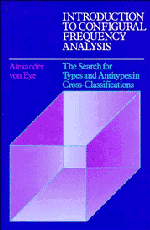 Introduction to Configural Frequency Analysis
Introduction to Configural Frequency Analysis Book contents
- Frontmatter
- Contents
- Preface
- Part I Concepts of configural frequency analysis
- Part II Applications and strategies of CFA
- Part III Methods of longitudinal CFA
- Part IV Strategies of CFA and computational issues
- 7 Exploratory and confirmatory search for types and antitypes
- 8 CFA and log-linear models
- 9 Computational issues
- Appendix A Computational issues. The estimation of tail probabilities for the standard normal and the F distributions
- Appendix B Estimation of expected frequencies in 2 × 2 × 2 tables under the assumption that main effects and first order interactions exist
- Appendix C Critical alpha levels under Holm adjustment for up to 330 cells and a priori alphas 0.05 and 0.01
- References
- Subject index
- Author index
9 - Computational issues
from Part IV - Strategies of CFA and computational issues
Published online by Cambridge University Press: 04 August 2010
- Frontmatter
- Contents
- Preface
- Part I Concepts of configural frequency analysis
- Part II Applications and strategies of CFA
- Part III Methods of longitudinal CFA
- Part IV Strategies of CFA and computational issues
- 7 Exploratory and confirmatory search for types and antitypes
- 8 CFA and log-linear models
- 9 Computational issues
- Appendix A Computational issues. The estimation of tail probabilities for the standard normal and the F distributions
- Appendix B Estimation of expected frequencies in 2 × 2 × 2 tables under the assumption that main effects and first order interactions exist
- Appendix C Critical alpha levels under Holm adjustment for up to 330 cells and a priori alphas 0.05 and 0.01
- References
- Subject index
- Author index
Summary
The present chapter introduces programs and shows how to apply some of the larger statistical software packages to obtain CFA results. Three levels of application will be covered: (1) pocket calculators; (2) microcomputers (PCs); and (3) main frame computers.
Programs for pocket calculators
Relatively small data problems can be handled using programmable pocket calculators. A program for first order CFA of dichotomous variables is available for calculators of the type HP 41 C, HP 41 CV, and HP 41 CX (von Eye 1982; the program is printed in this reference; mag-card versions are also available.) The program can be applied if the following periphery is available in addition to the calculator:
(1) Quad-memory (required for HP 41 C only);
(2) mag-card reader or digital cassette drive to read program;
(3) printer.
This program allows one to analyze up to seven variables. All variables must be dichotomous. The program calculates the marginals and the expected frequencies from the raw frequencies, gives both the Pearson chi-square components and Lehmacher's z, and calculates the tail probabilities for z using an algorithm from Abramowitz and Stegun (1970).
A second program for the same type pocket calculators computes second order CFA for three variables using the approximation given in Appendix B. Application of this program requires the same periphery as above. The program calculates marginals, expected frequencies, Pearson chi-square components, and the tail probabilities for the chi-square values using an approximation given in Abramowitz and Stegun (1970).
- Type
- Chapter
- Information
- Introduction to Configural Frequency AnalysisThe Search for Types and Antitypes in Cross-Classification, pp. 222 - 238Publisher: Cambridge University PressPrint publication year: 1990
